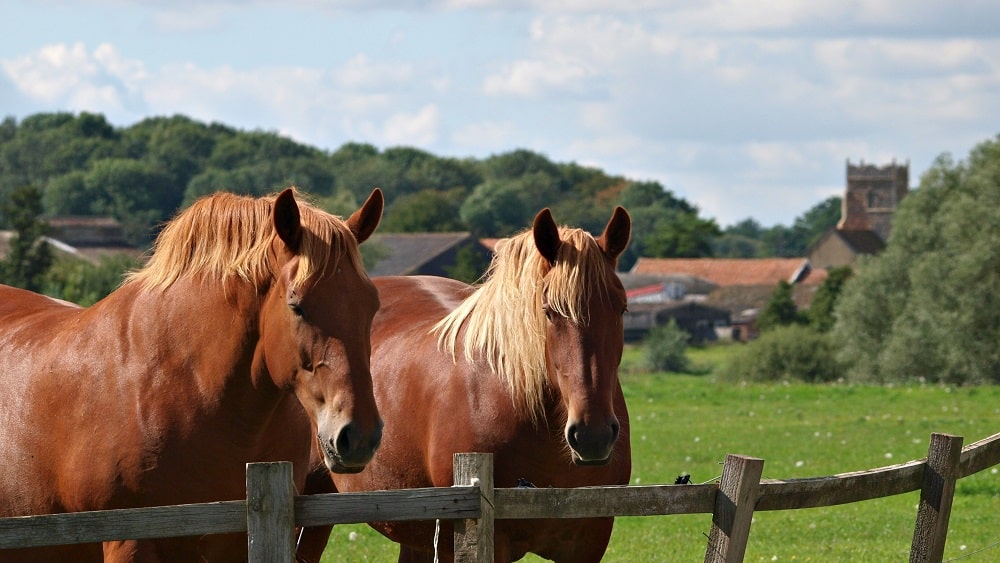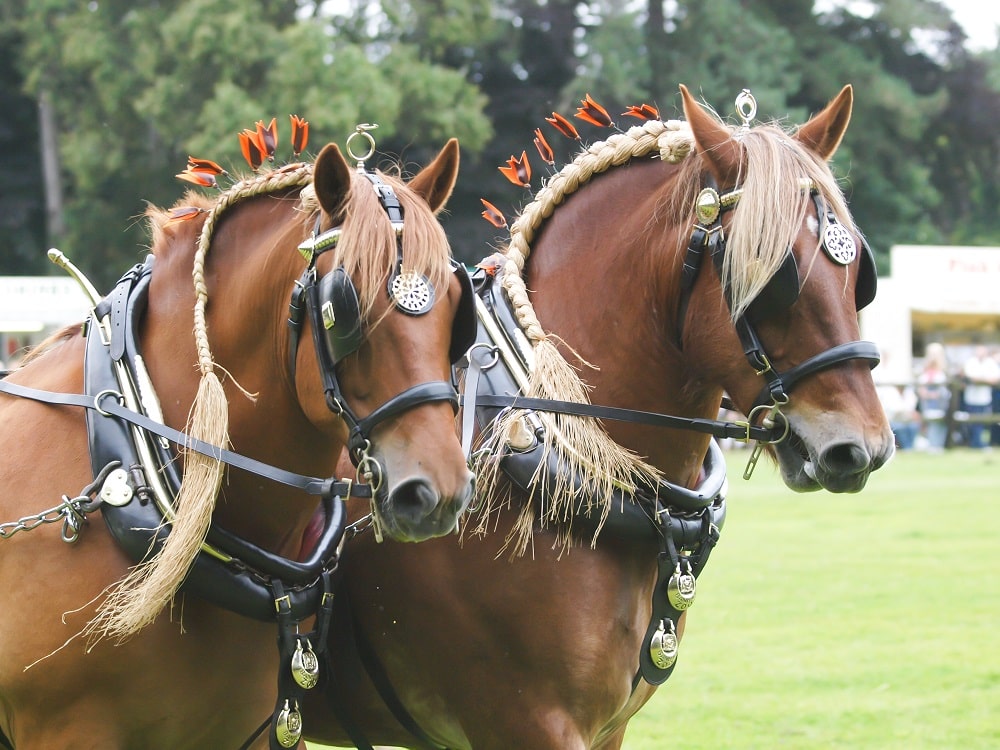
Vital Stats
| WEIGHT: | 900kg – 1000kg |
| HEIGHT: | 16.1 hands to 17.2 hands |
| LIFE EXPECTANCY: | 25 – 30 years |
| BEST FOR: | Economical to keep, work, heavy horse riding |
| ORIGIN: | Suffolk, England |
Order now for delivery on Tuesday 9th December
Originating in Suffolk, England – from where it gets its name – the Suffolk Punch is also known as the Suffolk Horse or the Suffolk Sorrel. This horse breed dates back to the 16th century, when it was bred for farm work; while the increasing popularity of machinery almost put the breed out of a job, the Suffolk Punch is still used for draught work in areas such as forestry.
With a short and stocky build, the Suffolk Punch is a hard worker known for its gentle temperament.
While there has been a resurgence in the breed’s popularity, the Suffolk Punch is still listed as ‘critical’ by the Rare Breeds Survival Trust, meaning that there are fewer than 300 breeding mares of the Suffolk Punch breed.


| WEIGHT: | 900kg – 1000kg |
| HEIGHT: | 16.1 hands to 17.2 hands |
| LIFE EXPECTANCY: | 25 – 30 years |
| BEST FOR: | Economical to keep, work, heavy horse riding |
| ORIGIN: | Suffolk, England |
The Suffolk Punch horse originated in Suffolk, England in the early 16th century; and is thought to be the oldest breed of heavy horse in Britain. All Suffolk Punch horses can trace their lineage back to a single stallion: “Crisp’s horse”, a stallion foaled in 1768.
The Suffolk Punch was originally bred for farm work by local farmers, who needed a horse with power, stamina and docility – traits which endure in the Suffolk Punch to this day.
The Suffolk Punch Registry is the oldest English breed society; it was followed in 1877 by the creation of the Suffolk Punch Horse Society, which aimed to promote the breed, and published the first stud book in 1880.
Throughout the 19th century, Suffolk Punch horses were exported to countries including Canada and the US; its popularity endured throughout the early 20th century, with Suffolk Punch horses finding their way around the world. However, the increasing use of machinery in agriculture combined with the devastating effect of the Second World War led to a decline in numbers of the Suffolk Punch, and in 1966 there were fewer than ten foals registered with the Suffolk Punch Registry.
The latter part of the 1900s saw a resurgence in the breed’s popularity, however while numbers have increased, the Suffolk Punch still remains on the Rare Breeds Survival Trust’s “Critical” list, with fewer than 300 breeding mares in existence.
Like other draught horses, the Suffolk Punch is a heavy horse; however, it tends to be shorter and stockier than fellow draught breeds such as the Shire and Clydesdale.
The Suffolk Punch stands at 16.1 – 17.2hh; and weighs in at around 900 – 1000kg.
The Suffolk Punch has a solid build, with a short and strong stature due to its breeding as an agricultural work horse. This breeding also influenced its lack of leg feathering, which made it easier for the horse to work in the heavy soil of its home counties in eastern England.
Perhaps its most defining feature of the Suffolk Punch is its colour: Suffolk Punch horses are always chestnut, which is spelt “chesnut” by the Suffolk Punch Society, and no other colour is allowed. The shade of chesnut can vary, however, with Suffolk Punch horses appearing in shades ranging from Dark Liver to Lemon and Bright. Currently, only five shades of chesnut are accepted by the Suffolk Punch Society: Liver, Dark, Red, Light, or Bright chesnut.
A few white or silver hairs mixed throughout the coat of a Suffolk Punch horse are accepted, as are a few white markings on the face – although these are rare. White to the fetlock is accepted, however is seen as a fault and is not allowed for stallions used for breeding.
Suffolk Punch horses are happy to eat a regular equine diet of quality hay, grain, vegetables and fruits. In comparison with their draught horse counterparts, they are able to live on a smaller amount of food, making them more economical to keep.
Having first originated in the early 16th century, the Suffolk Punch is the oldest breed of English heavy horse. It has a stockier build than some of its draught horse counterparts, and is recognisable for its exclusively chesnut colouring, with horses of any other colour not allowed by breed registries.
They are also something of an icon in their home county of Suffolk, with local football team Ipswich Town F.C. including a Suffolk Punch horse on their team crest.
The Suffolk Punch has gained a reputation as an incredibly gentle and calm horse, with a strong work ethic and a will to please – characteristics which are typical of a draught horse.
Bred for farm work, they are determined and make excellent workers.
The Suffolk Punch is a generally healthy breed, with few common health issues to watch out for.
However, the breed can be susceptible for health conditions which affect a number of draught horses. These include Equine Polysaccharide Storage Myopathy (EPSM), a condition which prevents horses from properly metabolising starches and sugars; shivers; and chronic progressive lymphedema: and chronic progressive lymphedema, a skin condition in some breeds of draught horse, which causes swelling of the lower legs.
Due to the low numbers of breeding mares of the Suffolk Punch breed, The Animal Health Trust and the Suffolk Horse Society are collaborating on a project to help Suffolk Punch breeders to reduce the risk of genetic problems in a bid to ensure the breed’s future survival.
Suffolk Punch horses typically require a standard equine grooming routine of hoof inspection and cleaning; coat care; and mane and tail brushing.
Their manes and tails can be braided to avoid tangling, and Suffolk Punch horses used for showing at the Suffolk Punch Spectacular feature a unique braid in their mane and tail, accented with rafia.
The typical lifespan of a Suffolk Punch horse is 25 – 30 years.
A hard working horse bred for farm work, the Suffolk Punch remains a popular choice for agricultural labour such as forestry, as well as other draught work. Their gentle, eager to please nature makes them a great choice for this type of work, as does their strength; while their relatively low food requirements and ability to work for long periods of time make them an economical choice too.
The Suffolk Punch is also used for crossbreeding, and can be a good option for heavy horse riders. They are popular in shows and are also used for promotional purposes, such as pulling drays for breweries.
